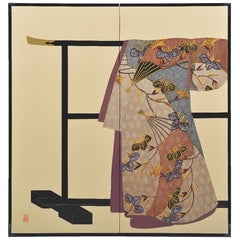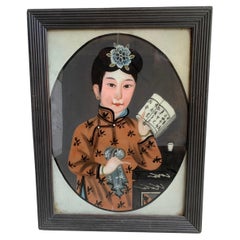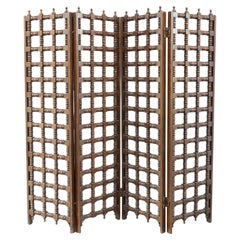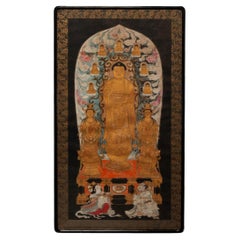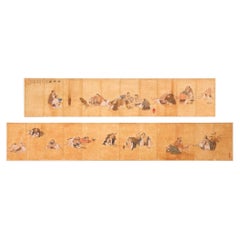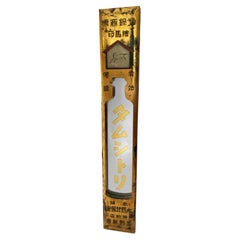Hand-Crafted Paintings and Screens
to
17
138
18
202
27
2
7
5
4
3
1
14
49
139
29
33
34
14
1
6
1
5
12
7
2
1
159
116
106
105
97
207
198
157
38
11
231
225
226
27
1
1
1
1
Technique: Hand-Crafted
Japanese Contemporary Orange Black Cream Silk Two-Panel Folding Screen, 4
Located in Takarazuka, JP
Extraordinary Japanese contemporary two panel "byobu" or folding screen featuring genryoku style handcrafted silk raised kimono Japanese decorative art in Purple, blue, black and ora...
Category
21st Century and Contemporary Japanese Meiji Hand-Crafted Paintings and Screens
Materials
Gold
Chinese Reverse Glass Painting of Woman, Early 20th Century
Located in Jimbaran, Bali
This Chinese portrait depicts a young woman and was painted using a reverse glass painting technique. Painting in reverse on the opposite side of a piece of glass meant the painter h...
Category
Early 20th Century Chinese Qing Hand-Crafted Paintings and Screens
Materials
Glass, Wood, Paint
French Mashrabiya Screen
Located in Southampton, GB
French Mashrabiya style Screen.
Four panelled structure, with a Charles Dudyout design influence.
France, circa 1920.
Height - 135cm
Panel Width - 34.5cm
Total Width - 139cm
Indivi...
Category
Early 20th Century French Hand-Crafted Paintings and Screens
Materials
Oak
$1,717
Antique Japanese Buddhist Ink & Color On Silk Painting Amida Triad Buddha
Located in Forney, TX
A beautiful framed antique Japanese School ink and color painting on silk, 19th century, finely detailed and richly colored, depicting Amida Triad, with two Bodhisattva attendants worshipping Buddha, on a gilt arabesque mat, in a black frame.
Provenance / Acquisition:
A Private Dallas Collector
Acquired from the highly reputable auction house Dallas Auction Gallery, Dallas, Texas. Summer Fine Arts and Antiques catalog.
Owned and curated by Reyne Hirsch, a notable media personality and expert in 20th century decorative arts. She's was a top appraiser for Antiques Roadshow...
Category
19th Century Japanese Edo Antique Hand-Crafted Paintings and Screens
Materials
Metallic Thread
FINE PAIR OF EXTRA LARGE BOISTEROUS EXPLOITS OF THE DRUNKEN IMMORTALS PAINTINGs
Located in West Sussex, Pulborough
Royal House Antiques
Royal House Antiques is delighted to offer for sale this stunning pair of Vintage Chinese paintings depicting the Boiste...
Category
20th Century Chinese Chinese Export Hand-Crafted Paintings and Screens
Materials
Pine
Antique Japanese Medicine "Kanban" 'Shop Sign', Late Meiji Period
Located in Point Richmond, CA
Antique Japanese Medicine "Kanban" (Shop Sign) with mirror, Meiji Period.
The Medicine being advertised is a soothing cream used to relieve itchin...
Category
Early 20th Century Japanese Meiji Hand-Crafted Paintings and Screens
Materials
Wood, Lacquer
China Beautiful Natural Mountain Waters Desktop "Painting"
Located in South Burlington, VT
This Chinese extraordinary natural stone marble "painting" of a mountain backdrop fronted by a peaceful body of water, is both unique and remarkable.
Called a dream stone Shih-hua it was cut from historic Dali marble found in the Cangshan mountains of western China. These mysterious mountains, unique in the world, are known for yielding incredible and fantastic natural landscaped works of art created over tens of millions of years from mineral inclusions that affected the process of ancient organic material which transformed into limestone and finally resulted in marble- a metamorphic hard stone.
Handsome custom hard wood frame
This particular dream stone is special- it is considered a master work of fine natural detail. We have had it framed in a handsome hardwood tabletop arts and crafts style frame...
Category
20th Century Chinese Hand-Crafted Paintings and Screens
Materials
Marble
$2,280 Sale Price
40% Off
Thai Painting of Temple Dancer and Buddhist Monkey God, Distressed, circa 1950
Located in Fort Lauderdale, FL
Antique Thai painting depicting an Aspara or dancing nymph in the forest with perhaps Hanuman, The Monkey God, recognized in both Hindu and Buddhist religio...
Category
1950s Thai Mid-Century Modern Vintage Hand-Crafted Paintings and Screens
Materials
Gold Leaf
Pair of Japanese Edo/Tokugawa Screens Tale of Heiki
Located in Rio Vista, CA
Monumental pair of late 18th century Japanese Edo/Tokugawa period byobu screens depicting the battles between Taira and Minamoto. The screens have six panels each with individual sce...
Category
19th Century Japanese Edo Antique Hand-Crafted Paintings and Screens
Materials
Brass, Gold Leaf
Pair of Chinese Hand Carved Jade and Wood Table Screens
Located in Guaynabo, PR
This is a 19th century pair of Chinese hand carved oval jade and hard stone table screens with wood stands. They depict a semitransparent large egg sh...
Category
19th Century Chinese Chinese Export Antique Hand-Crafted Paintings and Screens
Materials
Jade
$3,040 Sale Price / set
20% Off
Japanese Chinese Asian Two-Panel Byobu Folding Screen Ancestral Immortal Figures
Located in Studio City, CA
A gorgeous, quite large, boldly colored, and alluring hand-painted two-panel Chinese/Japanese/Asian Byobu folding screen depicting 18 exquisitely clad male ancestral or immortal figu...
Category
20th Century Hand-Crafted Paintings and Screens
Materials
Gold Leaf
Japanese Contemporary Red Black Cream Folding Screen Silk Brocade Kimono Art, 3
Located in Takarazuka, JP
Exceptional Japanese contemporary two panel "byobu" or folding screen featuring genryoku style handcrafted silk raised kimono Japanese decorative art in crimson red, black and gold o...
Category
21st Century and Contemporary Japanese Meiji Hand-Crafted Paintings and Screens
Materials
Gold
Japanese Contemporary Framed Green Red Black Gold Decorative Art
Located in Takarazuka, JP
Exquisite Japanese contemporary framed three-dimensional decorative art piece in Japanese silk kimono fabric in vivid red, green and black on gold leaf Japanese paper, recreating a s...
Category
21st Century and Contemporary Japanese Meiji Hand-Crafted Paintings and Screens
Materials
Gold Leaf
Inside Painted Glass, "Landscape" Snuff Bottle by Fu Guoshun, 1996
Located in Tainan, TW
Fu Guoshun was born at Hebei in 1954. He was complimented as a Master of Chinese arts and crafts in 2012. It is the highest honor for an inside painting artist. There are only ten artists who earned this glory. He is also the director of China International Painting and Calligraphy Association, vice chairman of China Snuff Bottle Professional Committee, and vice-chairman of Hebei Inside painted snuff bottle Association. Since 1977, he has been studying the art of inside painting under Wang Xisan. Fu Guoshun is one of the best artists in Ji school.
Mr Fu Guoshun's inside paintings are exquisite. His works include landscapes, figures, animals, flowers, and birds to calligraphy with comprehensive skills. In addition, his professions are known for their elegance, flexibility, and light. With the three superb skills of poetry, calligraphy, and painting, there are only a handful of artists who can match up in the field of snuff bottles. It is difficult to find other artists who could compare his paintings from an artistic perspective when it comes to inside painted snuff bottles...
Category
20th Century Chinese Modern Hand-Crafted Paintings and Screens
Materials
Glass
A Burmese painting showing a colourful scene of a a ceremonial celebration
Located in Central England, GB
This most eye catching piece of fine artwork dates to circa 1930 and is a Burmese painting on fine canvas laid onto a card and shows a kaleidoscope typ...
Category
Mid-20th Century Burmese Primitive Hand-Crafted Paintings and Screens
Materials
Canvas, Wood
Japanese Two Panel Screen Chrysanthemums Through the Mist Obara Art Screen
Located in Hudson, NY
Japanese two panel screen: Chrysanthemums Through the Mist Obara Paper Art Screen. Surreal and masterful rendering of chrysanthemums cloaked in mist that varies in opacity made entirely of carefully arranged mulberry paper fibers in a Japanese art practice called Obara. Accented with gold leaf. Unique in terms of both execution and dreamlike mood. Made by Yamauchi Issei (b. 1929), stamped in the corner. Issei is well known throughout Japan as the leading artist in Obara Paper Art. Starting in 1948, he apprenticed with Fuji Tatsukichi, a leading proponent of the arts and crafts movement in Japan who worked to revive many cultural traditions on the brink of extinction. Issei started exhibiting in the Nitten in 1953, won the gold medal in 1963, and eventually became a juror. His artwork was given as a gift to the Showa Emperor of Japan, as well as dignitaries such as General Douglas MacArthur...
Category
Mid-20th Century Japanese Showa Hand-Crafted Paintings and Screens
Materials
Wood, Paper
Unique Hand Decorated "Romantic Family" Arts & Crafts Wood Settle Rhode Island
Located in South Burlington, VT
From an important thirty year old New England collection of hand decorated pyrography Arts & Crafts furnishings.
Unique work of art with a Rhode Island origin.
A romantic compositio...
Category
Early 20th Century American Arts and Crafts Hand-Crafted Paintings and Screens
Materials
Wood
Japanese Taisho Two Panel Screen Heian Period Flute Player
Located in Rio Vista, CA
Extraordinary Japanese Taisho period two panel byobu screen depicting Fujiwara Yasumasa playing the flute in the Ichihara Moor. Fujiwara Yasumasa (958 to 1036) was a famous Heian period...
Category
20th Century Japanese Taisho Hand-Crafted Paintings and Screens
Materials
Silk, Wood, Paper
Antique kimono textile art " Peacock Feathers ~Royalty~ " by ikasu Blue , Japan
By Kimono ikasu
Located in Setagaya City, JP
This work uses an antique furisode (festive kind of kimono with long sleeves) with peacock feathers - a symbol of royalty and prosperity. Can be used both vertically and horizontally...
Category
Early 20th Century Japanese Japonisme Hand-Crafted Paintings and Screens
Materials
Gold Leaf, Silver Leaf
Showa Period Plum Blossoms Fusuma
Located in Fukuoka, JP
Size: The door size is 90 x 188 cm (35.4 x 74 inches)
Number of doors: 6 pieces
Period: Showa (1926-1989)
This exquisite 6-panel fusuma screen, hailing from the Showa period, captures the serene beauty of Japan's beloved plum blossoms. Each panel is meticulously crafted with high-quality Japanese paper, providing a delicate backdrop for the elegantly hand-painted plum tree that spans across the panels. The artwork vividly portrays the fleeting beauty of early spring, where plum blossoms emerge in a burst of life against tranquil landscapes. The fusuma panels...
Category
20th Century Japanese Showa Hand-Crafted Paintings and Screens
Materials
Wood, Paper
Japanese Green Yellow Brown Framed Porcelain Panel by Master Artist
Located in Takarazuka, JP
Exquisite Japanese contemporary hand-painted Kutani porcelain framed porcelain panel in a square shape, one of the artist's signature works depicting C...
Category
21st Century and Contemporary Japanese Hand-Crafted Paintings and Screens
Materials
Porcelain
Romantic Unique Hand Decorated "Throne Chair" Arts & Crafts Rhode Island
Located in South Burlington, VT
From an important thirty year old New England collection of hand decorated pyrography Arts & Crafts furnishings.
Unique work of art with a Rhode Island origin.
A romantic hand carved and hand painted one-of-a-kind throne chair painting and pyrography on wood attributed to the circle of Lawrence Pennington, early 20th century, Warwick, Rhode Island.
This is a beautiful early 20th century high back...
Category
Early 20th Century American Arts and Crafts Hand-Crafted Paintings and Screens
Materials
Wood
Pair of Six Panel Japanese Edo Screens Chrysanthemums Along Fence
Located in Rio Vista, CA
Remarkable pair of early 19th century Japanese late Edo period screens depicting summer chrysanthemums growing along a brushwood fence. Ink and...
Category
19th Century Japanese Edo Antique Hand-Crafted Paintings and Screens
Materials
Silver Leaf
Tsumikasanattamono by Wataru Hatano BK Small_A
Located in Sammu-shi, Chiba
Japan / 2021s
Size : W900 D25 H1200 mm
Kuroya Washi artist Hatano Wataru's masterpiece "Stacked Things" series. Japanese paper, soil, pigments, etc. are layered on top of each other to express the beauty of what has been accumulated over the years.
[Wataru Hatano...
Category
2010s Japanese Japonisme Hand-Crafted Paintings and Screens
Materials
Sandstone
Large Framed Silk and Brocade Japanese Contemporary Oshie Wall Decorative Art
Located in Takarazuka, JP
Large Japanese contemporary framed silk and brocade Oshie wall decorative art, exceptional Japanese contemporary framed and signed three-dimensional wall decorative art piece in silk...
Category
21st Century and Contemporary Japanese Hand-Crafted Paintings and Screens
Materials
Brocade, Silk
19th Century Asian Hand Carved Screen with Mountains, Trees and Sea Gulls
Located in Lomita, CA
Sea, Sky and Birds populate the hand carving of this screen. The delicate open hand-carving on this screen is distinctive. This is a late 19th, early 20th century Chinese divider screen...
Category
Late 19th Century Chinese Chinese Export Antique Hand-Crafted Paintings and Screens
Materials
Wood
$1,196 Sale Price
20% Off
Japanese Contemporary Framed Red Black Silk Brocade Oshie Decorative Art
Located in Takarazuka, JP
A sophisticated technique is used to transform highest quality kimono fabrics into exquisite antique pieces of kimono fabric to recreate a Genryoku kosode kimono . Tagasode is the wa...
Category
21st Century and Contemporary Japanese Meiji Hand-Crafted Paintings and Screens
Materials
Silk, Brocade
Vintage kimono textile art "Fern ~Connection to Nature~" by ikasu Black , Japan
By Kimono ikasu
Located in Setagaya City, JP
This work uses an antique tomesode (festive kind of kimono) with fern design to evoke feelings of tranquility, harmony, and appreciation for the beauty of the environment. Can be used both vertically and horizontally.
It is elegantly framed with paulownia wood originally used for kimono chest-of-drawers, and is filled with storytelling and sense of luxury.
I used pieces of kimono that could no longer be used as clothing and kiritansu chest-of-drawers that would normally be discarded to create the ultimate upcycled piece.
<< Explanation of colors and patterns >>
In Japanese traditional culture, ferns, particularly the Japanese painted fern (Athyrium niponicum), hold several meanings and symbolisms:
・Elegance and Beauty: Ferns are admired for their graceful, delicate appearance and intricate leaf patterns. In Japanese aesthetics, they are appreciated for their natural beauty and are often used in gardens, landscapes, and floral arrangements to add a sense of refinement and elegance.
・Resilience and Perseverance: Ferns are known for their ability to thrive in diverse environments, including shady forests, rocky cliffs, and damp soil. Their resilience in the face of challenging conditions is seen as a symbol of endurance and perseverance. In Japanese culture, ferns may represent the ability to overcome adversity and flourish despite obstacles.
・Connection to Nature and Tranquility: Ferns are native to forested areas and are often associated with the natural world. In Japanese traditional culture, they symbolize a deep connection to nature and the importance of maintaining harmony with the environment. The lush green foliage of ferns evokes feelings of tranquility and peacefulness, making them popular motifs in Zen gardens and traditional landscape paintings.
・Purity and Simplicity: Ferns are emblematic of simplicity and purity in Japanese aesthetics. Their unassuming beauty and understated elegance reflect the principles of wabi-sabi, an aesthetic worldview that values imperfection, impermanence, and simplicity. Ferns may be used in tea ceremonies, Ikebana (flower arranging), and other traditional arts to evoke a sense of tranquility and appreciation for life's fleeting moments.
Overall, ferns in Japanese traditional culture symbolize elegance, resilience, connection to nature, purity, and simplicity. Their presence in art, literature, and landscape design underscores their enduring significance as symbols of natural beauty and spiritual resonance.
<< Characteristics of the fabric >>
This vintage textile is hand-painted with a traditional Japanese technique called "yuzen".
<< About the frame >>
Kiritansu - chest-of-drawers for kimono, is traditionally made from paulownia wood, a uniquely Japanese material closely tied to the world of kimonos.
Paulownia wood is known as the lightest wood in Japan, prased for its natural luster, resistance to moisture, and resilience against cracking. Since ancient times, it has been used in crafting furniture, chests, and musical instruments.
During the Edo period, it became customary to store cherished kimonos in paulownia chests...
Category
1960s Japanese Japonisme Vintage Hand-Crafted Paintings and Screens
Materials
Silk, Wood
Antique kimono textile art " Kobachi ~ Coral Collection ~ " by ikasu Pink, Japan
By Kimono ikasu
Located in Setagaya City, JP
This work is inspired by the coral color palette, and is framed in paulownia wood originally used for a kimono chest-of-drawers.
In this artwork, the aim was to capture the wide pal...
Category
1920s Japanese Japonisme Vintage Hand-Crafted Paintings and Screens
Materials
Silk, Wood
Japanese Traditional Brocade Silk Two-Panel Folding Screen
Located in Takarazuka, JP
Japanese contemporary two-panel "byobu" or folding screen featuring two graceful ladies dressed in elegant formal traditional Japanese kimonos. This folding screen is inspired by Jap...
Category
21st Century and Contemporary Japanese Meiji Hand-Crafted Paintings and Screens
Materials
Brocade, Silk
Contemporary Japanese Red Black Gilded Silk Folding Screen
Located in Takarazuka, JP
Extraordinary Japanese contemporary two panel "byobu" or folding screen featuring genryoku style handcrafted raised pure silk kimono in black, red and gold on textured black backgrou...
Category
21st Century and Contemporary Japanese Meiji Hand-Crafted Paintings and Screens
Materials
Silk, Brocade
Pair Antique 19th Century 1880 Chinese Gouaches on Rice Paper Geisha Girl & Lord
Located in West Sussex, Pulborough
We are delighted to offer for sale this lovely pair of antique circa 1880’s Chinese hand painted Gouache paintings depicting a Geisha girl and Lord
A very good looking and beautifully painted pairing, they were made for the export market during the British colonialism...
Category
1880s Chinese Chinese Export Antique Hand-Crafted Paintings and Screens
Materials
Paper
VIntage kimono textile art "Geometry ~Chrysanthemums" by ikasu, white, red Japan
By Kimono ikasu
Located in Setagaya City, JP
This work is inspired by traditional Japanese natural symbolism, and is framed in paulownia wood originally used for a kimono chest-of-drawers.
It is elegantly framed with paulownia...
Category
1960s Japanese Japonisme Vintage Hand-Crafted Paintings and Screens
Materials
Silk, Wood
Tsumikasanattamono by Wataru Hatano BK Small_B
Located in Sammu-shi, Chiba
Japan / 2021s
Size : W900 D25 H1150 mm
Kuroya Washi artist Hatano Wataru's masterpiece "Stacked Things" series. Japanese paper, soil, pigments, etc. are layered on top of each other to express the beauty of what has been accumulated over the years.
[Wataru Hatano...
Category
2010s Japanese Japonisme Hand-Crafted Paintings and Screens
Materials
Sandstone
Japanese Contemporary Silk Brown Black Cream Two-Panel Folding Screen, 3
Located in Takarazuka, JP
Extraordinary contemporary Japanese two-panel "byobu" or folding screen showcasing genryoku style handcrafted raised embroidered silk brocade kimono Japanese decorative art in autumn...
Category
21st Century and Contemporary Japanese Meiji Hand-Crafted Paintings and Screens
Materials
Gold
Hidetaka Ohno "Red No.2-15", 1964 Oil and Burlap Collage
By Hidetaka Ohno
Located in Sharon, CT
Red No.2-15 by Hidetaka Ohno, signed and dated (1964) verso. Labels from the Yamada Art Gallery, Tokyo, and from The Corcoran Gallery of Art, D.C. stating that this was exhibited as ...
Category
1960s Japanese Brutalist Vintage Hand-Crafted Paintings and Screens
Materials
Burlap
Tsumikasanattamono by Wataru Hatano
Located in Sammu-shi, Chiba
Japan / 2021s
Size : W1200 D25 H1600 mm
Kuroya Washi artist Hatano Wataru's masterpiece "Stacked Things" series. Japanese paper, soil, pigments, etc. are layered on top of each other to express the beauty of what has been accumulated over the years.
[Wataru Hatano...
Category
2010s Japanese Japonisme Hand-Crafted Paintings and Screens
Materials
Sandstone
Japanese Contemporary Framed Blue Purple Gray Silk Brocade Decorative Art
Located in Takarazuka, JP
Japanese contemporary framed three-dimensional decorative art piece in Japanese traditional silk and brocade in soft green, blue and purple on a deep gray background, recreating an 1...
Category
21st Century and Contemporary Japanese Meiji Hand-Crafted Paintings and Screens
Materials
Brocade, Silk
Tsumikasanattamono by Wataru Hatano BK
Located in Sammu-shi, Chiba
Japan / 2021s
Size : W1200 D25 H1550 mm
Kuroya Washi artist Hatano Wataru's masterpiece "Stacked Things" series. Japanese paper, soil, pigments, etc. are layered on top of each other to express the beauty of what has been accumulated over the years.
[Wataru Hatano...
Category
2010s Japanese Japonisme Hand-Crafted Paintings and Screens
Materials
Sandstone
Vintage obi textile art " Camellia ~ Serendipity ~ " by ikasu Blue, Japan
By Kimono ikasu
Located in Setagaya City, JP
This work is inspired by traditional Japanese nature motifs symbolism, and is framed in paulownia wood originally used for a kimono chest-of-drawers.
In this artwork, the aim was to capture the the auspicious symbol of camellia used in antique kimono. Traditional Japanese culture, represented by the kimono, and wood, an integral element of Japanese craftsmanship, were used to bring this vision to life.
I used pieces of kimono that could no longer be used as clothing and kiritansu chest-of-drawers that would normally be discarded to create the ultimate upcycled piece.
<< Explanation and meaning of pattern and colors >>
This delicate piece features hand-drawn camellia motifs flowing gracefully on a softly brightened grayish background.
Camellias, native to Japan, bloom from winter to early spring. As an evergreen tree with green leaves throughout the year, it symbolizes the anticipation of spring and is considered an auspicious plant. Due to its seasonal significance and auspicious meanings, camellias have been used as motifs symbolizing good fortune. Additionally, they were highly valued for their use in oil, cosmetics, and medicine, representing nobility. Believed to possess the power to ward off misfortune, camellias also carry the meaning of "protection from calamity" and have strong ties to traditional ceremonies. In this artwork, camellias are delicately depicted alongside flowing branches, subtly representing good fortune with their pale pink and white hues.
"Sora-iro nezumi 空色鼠" refers to a light grayish color with a hint of blue, reminiscent of the slightly brightened sky on a lightly cloudy day. Popular during the late Edo period (19th cent.), it elegantly captures the slightly brighter sky pattern seen on lightly overcast days. Notably, the term "nezumi-iro" (mouse gray), popular during the late Edo period, was paired with brown tones, collectively known as "Forty-eight Teas and a Hundred Mice 四十八茶百鼠." Colors within the "nezumi" (gray) spectrum, particularly "sora-iro nezumi," were favored by young people for their cool and sophisticated appeal.
<< Characteristics of the fabric >>
The fabric features intricately woven patterns that reveal subtle gradations through dyeing, creating a grid pattern that transforms depending on the light conditions.
Originally, this fabric was part of a formal kimono known as a "hōmongi 訪問着," featuring motifs along the hem, shoulders, and sleeves. These motifs have been carefully selected and combined to create a unified piece of artwork.
<< About the frame >>
Kiritansu - chest-of-drawers for kimono, is traditionally made from paulownia wood, a uniquely Japanese material closely tied to the world of kimonos.
Paulownia wood is known as the lightest wood in Japan, prased for its natural luster, resistance to moisture, and resilience against cracking. Since ancient times, it has been used in crafting furniture, chests, and musical instruments.
During the Edo period, it became customary to store cherished kimonos in paulownia chests...
Category
1960s Japanese Japonisme Vintage Hand-Crafted Paintings and Screens
Materials
Silk, Wood
Original Liberty London 19th Century Chinese Canton Brush Painting Watercolor
Located in West Sussex, Pulborough
We are delighted to offer for sale this very rare original 19th century watercolor brush painting depicting a scene of typical every day Chinese life retailed through Liberty London....
Category
19th Century Chinese Modern Antique Hand-Crafted Paintings and Screens
Materials
Paint
$769 Sale Price
30% Off
VIntage kimono textile art " Monochrome Geometry " by ikasu Gold, Grey, Japan
By Kimono ikasu
Located in Setagaya City, JP
This work is inspired by traditional Japanese nature colors symbolism, and is framed in paulownia wood originally used for a kimono chest-of-drawers.
It is filled with storytelling ...
Category
1960s Japanese Japonisme Vintage Hand-Crafted Paintings and Screens
Materials
Silk, Wood
Vintage obi textile art "Under the Sun ~Serendipity " by ikasu Red / Beige Japan
By Kimono ikasu
Located in Setagaya City, JP
This artwork creatively uses tree bark to evoke the imagery of woods and mountains during both the morning and nighttime on left and right. It is elegantly framed with paulownia wood, a tree closely connected to kimono culture, and is filled with storytelling and sense of luxury.
By incorporating both the front and back sides of the same obi fabric woven in different colors, the play of light and shadow on the mountains is depicted through the contrasting appearances of these surfaces.
The intention behind this piece is to convey the exquisite beauty of Japanese mountains and the lush forests that inhabit them. To achieve this, traditional elements of Japanese culture, such as obi textiles and craftsmanship involving wood, were used.
The outer side and inner linings of the same obi, no longer suitable for clothing, along with bark material that would normally be discarded, have been repurposed to create this exceptional upcycle artwork.
The fusion of Japanese natural materials – silk, paulownia wood, and pine bark for the central decoration – along with the so-called "Tozan" pattern, a unique Japanese natural design showing mountains from far-away point, captures the magnificent beauty of Japanese nature from various perspectives.
The central bark decoration stands out as a distinctive feature of this work. Pine, oak, and other tree barks are interwoven among the mountains woven into the obi, creating a tangible and authentic natural atmosphere.
<< Period / Story >>
The obi used in this piece was originally crafted during the late Showa period (1960-80ies).
<< Explanation and meaning of pattern and colors >>
This upcycle artwork uses an obi with a tozan pattern woven in two colors. The design is inspired by a distant mountain range, a motif that has been used in paintings and crafts since ancient times. However, in this particular design, the mountains are depicted not as distant peaks but as graceful semicircles giving it a mild atmosphere.
<< Characteristics of the fabric >>
This upcycled Fukuro-obi (two-side obi) showcases a festive color pattern of mountains intricately woven with gold threads against a beige front and red on the back.
The way this obi interacts with light allows it to shift in expression, much like a mountain revealing different facets over time. It can transform from deep shades of color to the appearance of gold shimmering against bright hues, depending on the lighting and viewing angle.
<< About the frame >>
Kiritansu - chest-of-drawers for kimono, is traditionally made from paulownia wood, a uniquely Japanese material closely tied to the world of kimonos.
Paulownia wood is known as the lightest wood in Japan, prased for its natural luster, resistance to moisture, and resilience against cracking. Since ancient times, it has been used in crafting furniture, chests, and musical instruments.
During the Edo period, it became customary to store cherished kimonos in paulownia chests...
Category
Late 20th Century Japanese Japonisme Hand-Crafted Paintings and Screens
Materials
Silk, Wood
Oil On canvas Signed By Anita McNamee, Winter Snow Landscape
Located in West Palm Beach, FL
This is an original painting, oil on canvas by Anita McNamee (FL, Circa mid 20th century.)
This is a post impressionism Winter Snow Landscape wi...
Category
Mid-20th Century American Prairie School Hand-Crafted Paintings and Screens
Materials
Canvas, Wood, Paint
VIntage kimono textile art "Geometry ~Marble~" by ikasu Gold, White, Grey, Japan
By Kimono ikasu
Located in Setagaya City, JP
This work is inspired by traditional Japanese nature motifs symbolism, and is framed in paulownia wood originally used for a kimono chest-of-drawers.
It is elegantly framed with pau...
Category
1960s Japanese Japonisme Vintage Hand-Crafted Paintings and Screens
Materials
Silk, Wood
Monumental Chinese Early to Mid 20th Century Hand Painted 4 Panel Folding Screen
Located in Milford, NH
A monumental Chinese hand painted polychrome canvas on wooden frame four panel folding screen featuring village scenes and figures on both sides, with rolling hills and trees. The sc...
Category
Mid-20th Century Chinese Hand-Crafted Paintings and Screens
Materials
Canvas, Wood, Paint
Set of Four Sliding Doors (Fusuma): Bamboo on Gold
Located in Hudson, NY
Meiji period (1868 - 1912) four separate fusuma doors (sliding doors) with paintings of bamboo trees. Can be hung separately, or together as shown. Signature in the process of bein...
Category
Late 19th Century Japanese Antique Hand-Crafted Paintings and Screens
Materials
Gold, Bronze, Gold Leaf
Set of Four Sliding Doors (Fusuma): Wild Grasses
Located in Hudson, NY
Meiji period (1868 - 1912) four separate sliding doors (fusuma) with Shijo School paintings of wild grasses. Can be hung separately, or together as shown. Signature reads: Kogetsu....
Category
20th Century Japanese Hand-Crafted Paintings and Screens
Materials
Bronze
Modern Framed Original Floral Watercolor on Rice Paper Painting by Caren Gafni
Located in Los Angeles, CA
Contemporary Framed Original Floral Watercolor Painting by Caren Gafni, Hand Painted Watercolor on Rice Paper, Glass Front 1.5" thick Wooden Frame with very soft Neutral Colors Magno...
Category
2010s American Hand-Crafted Paintings and Screens
Materials
Glass, Wood, Hardwood, Paint, Paper
Vintage obi textile art "Broken Vase ~kintsugi~" by ikasu Black / Gold, Japan
By Kimono ikasu
Located in Setagaya City, JP
This textile artwork uses a vintage obi dated around 1980ies, with a feather motif, and arranges it so that it looks like a vase.
Antique obi, just as it is a broken vase, is united back again with black obijime - a string used to tie up obi when it’s worn. Framed in kiritansu (antique chest) paulownia wood.
It is elegantly framed with paulownia wood originally used for kimono chest-of-drawers, and is filled with storytelling and sense of luxury.
I used pieces of kimono that could no longer be used as clothing and kiritansu chest-of-drawers that would normally be discarded to create the ultimate upcycled piece.
<< Explanation and meaning of pattern and colors>>
Feathers hold various meanings and symbolism in Japanese traditional culture, often reflecting themes of spirituality, symbolism, and folklore. Here are some of the meanings associated with feathers in Japanese tradition:
・Divine Protection: Feathers are often seen as symbols of divine protection and spiritual guidance. Feathers, especially those from birds, are considered to be imbued with the protective energy, offering spiritual guardianship and safeguarding against negative forces.
・Connection to the Spirit World: Feathers are sometimes associated with the spirit world and the realm of the divine. In folklore and mythology, feathers are depicted as messengers between the earthly realm and the celestial realms.
・Symbol of Beauty and Elegance: Feathers are admired for their natural beauty, grace, and elegance. In traditional Japanese arts such as Noh theater, Kabuki, and dance performances like Kagura, actors and performers often use feathered costumes or accessories to enhance their appearance and convey a sense of refinement and sophistication.
・Sign of Good Luck and Prosperity: In Japanese folklore, certain birds like cranes and pheasants are considered symbols of good fortune, longevity, and prosperity. Feathers from these birds are often depicted in art and craftwork as auspicious symbols believed to bring blessings and positive energy to the bearer.
<>
Kiritansu - chest-of-drawers for kimono, is traditionally made from paulownia wood, a uniquely Japanese material closely tied to the world of kimonos.
Paulownia wood is known as the lightest wood in Japan, prased for its natural luster, resistance to moisture, and resilience against cracking. Since ancient times, it has been used in crafting furniture, chests, and musical instruments.
During the Edo period, it became customary to store cherished kimonos in paulownia chests...
Category
1980s Japanese Japonisme Vintage Hand-Crafted Paintings and Screens
Materials
Silk, Wood
Harmonious Disarmament
By John Brevard
Located in Coral Gables, FL
this avant-garde sculpture emerges as a poignant narrative, a dialogue between the rawness of natural elements and the stark reality of human conflict. Crafted meticulously from clay...
Category
2010s Virgin Islands Modern Hand-Crafted Paintings and Screens
Materials
Sandstone
$16,880
Recently Viewed
View AllMore Ways To Browse
Japanese Screen Snow
Japanese Calligraphy Screen
Japanese Reverse Painting
Japanese Four Panel Silk Screen
Japanese Mountain Scrolls
Gold Paper Byobu
Japanese Cherry Blossom Screen
Heron Japanese
Japanese Screen Cherry
Japanese Three Panel Screen
Japanese Crane Screen
Japanese Screen 20th Century Four Panel
Japanese Silver Leaf Screen
Japanese Tiger Painting
Japanese Screen Of Fans
Meiji Era Screen
Japanese Painting Women
Japanese Screens With Cranes
